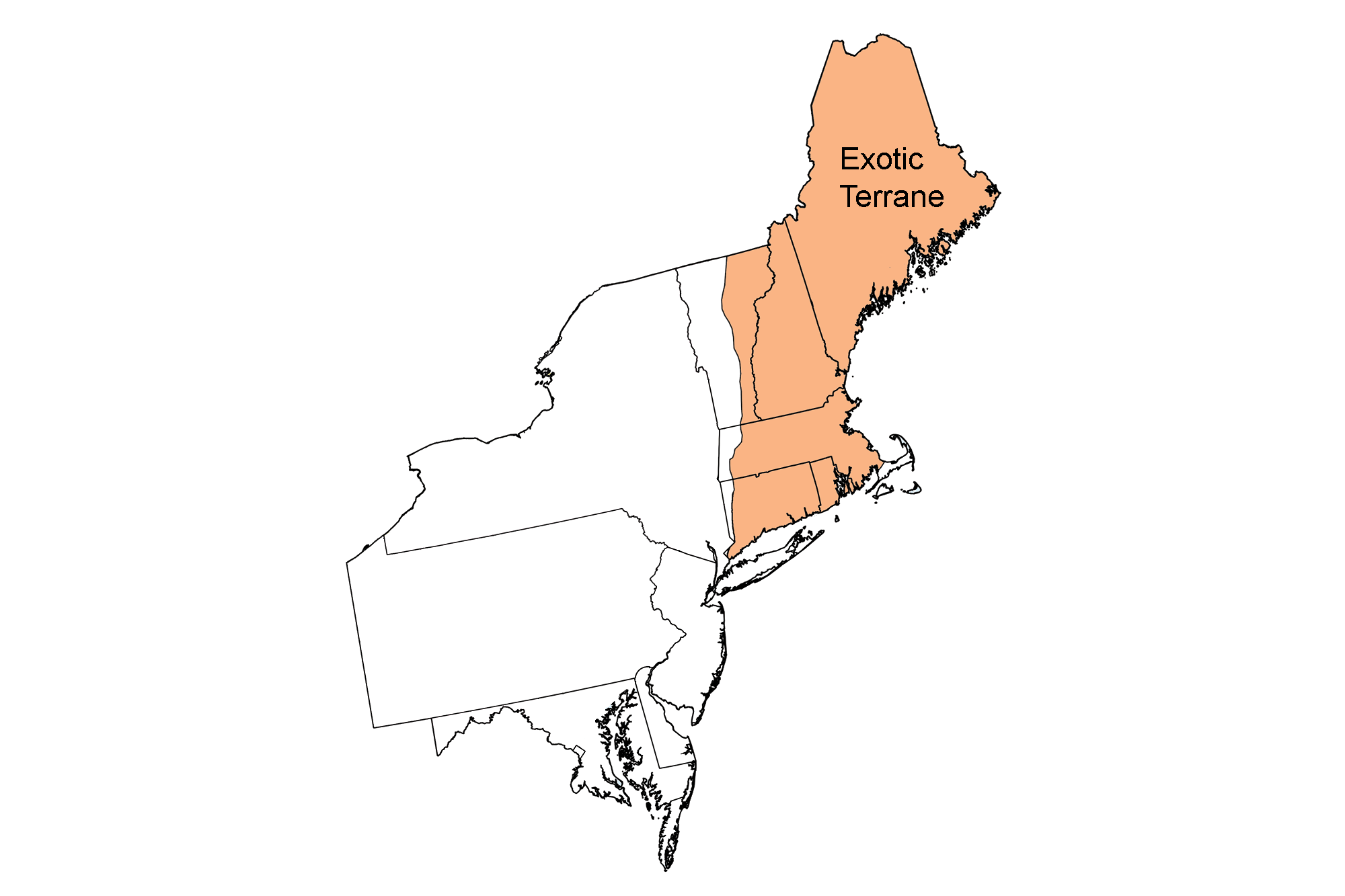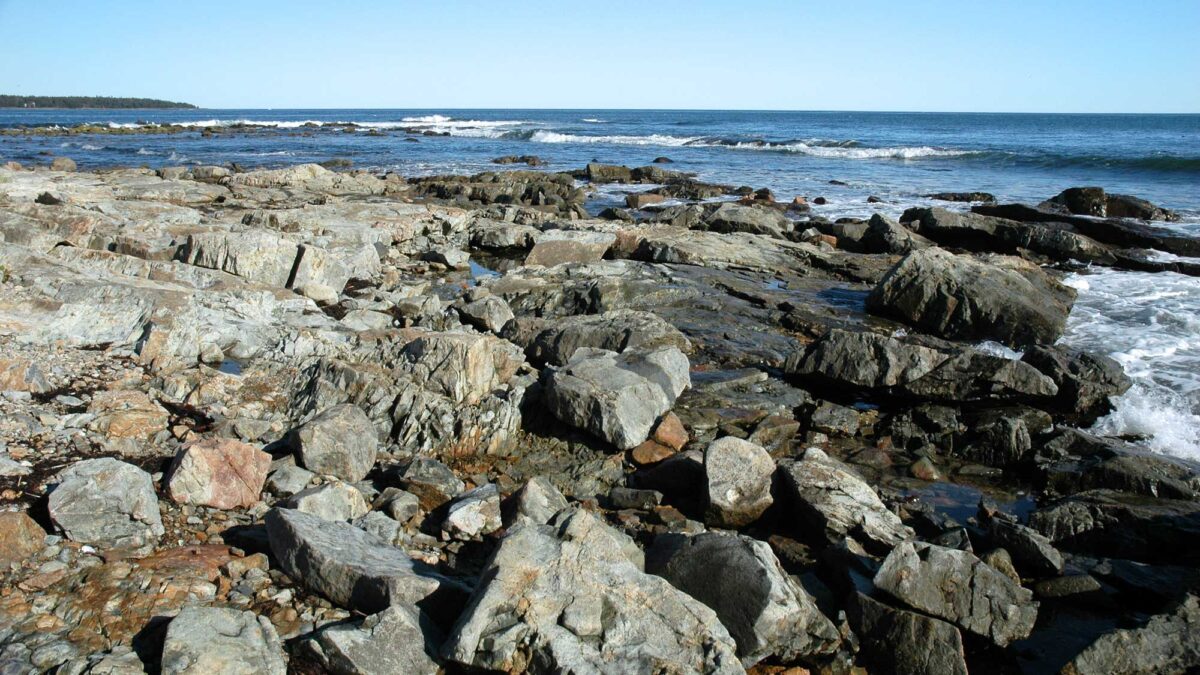Spotlight: Overview of the rocks of the Exotic Terrane region of the northeastern United States, including Maine, New Hampshire, eastern Vermont, Massachusetts, Rhode Island, and Connecticut.
Topics covered on this page: Overview; Precambrian; Paleozoic; Mesozoic; Resources.
Credits:Most of the content of this page is derived from The Teacher-Friendly Guide to the Geology of the Northeastern U.S. (published in 2000 by the Paleontological Research Institution; currently out of print) by Jane E. Ansley. The book was adapted for the web by Andrielle Swaby, Elizabeth J. Hermsen, and Jonathan R. Hendricks. Changes include formatting and revisions to the text and images. Credits for individual images are given in figure captions.
Updates: Page last updated September 28, 2023.
Image above: Silurian Metatuffs at Acadia National Park in Maine. Photograph by James St. John (Flickr; Creative Commons Attribution 2.0 Generic license; image cropped and resized).

Overview
There are two basic divisions of the Exotic Terrane region of New England: the Iapetus Rocks, recording the sediments deposited in the ancient Iapetus Ocean, and the Avalonia Rocks, recording the distinctive rocks of the Avalonia microcontinent, which were caught in the middle of the collision between North America and Baltica. The Iapetus and Avalonia Rocks were not originally part of North America. Indeed, the rocks have distinctly different geologic characteristics than the bulk of North America.
The Exotic Terrane region is dominated by igneous and metamorphic rocks. Both the Iapetus Terrane rocks and the Avalonia Terrane rocks are cut through with igneous intrusions that formed as magma cooled within the compressed crust and volcanic rocks that formed from volcanoes as lava broke out of the crust. The remaining rocks of the Exotic Terrane region are metamorphosed sedimentary rocks that originated as sediments on the continental shelf of North America, the floor of the closing Iapetus Ocean basin, and shed off of the approaching volcanic islands. In some places, especially northern Maine, the sedimentary rocks were only weakly metamorphosed and still retain much of their original character.
Precambrian
Precambrian rock in the Exotic Terrane region is found in eastern Massachusetts, Rhode Island, and Connecticut, and northwestern Maine. Eastern Massachusetts, Rhode Island and Connecticut were the Avalonia rocks that collided with North America during the Acadian mountain-building event. Though it is gneiss, the Avalonia gneiss is not the same as the Precambrian Grenville gneiss. The Avalonia rocks were far to the southeast of In northwestern Maine, the mountainous Chain Lakes Massif gneiss stands out as distinctly different from the surrounding rocks. Geologists continue to debate the origin of the Chain Lakes Massif, which is puzzling because of the intensely metamorphosed rocks. It is possible that this mass of gneiss was part of the Grenville belt of sediments.
Paleozoic rocks
Cambrian to Ordovician
Close to the Chain Lakes Massif of Maine are several occurrences of ophiolites. Geologists believe that the ophiolites were scraped off a subducting oceanic plate and welded onto the Chain Lakes Massif sometime during the Ordovician.
During the late Ordovician, as the Taconic volcanic islands approached North America, slices of crust were stacked and squeezed like a collapsing telescope across the Exotic Terrane and Appalachian/Piedmont regions. In the Exotic Terrane region, we see the remains of the volcanic island chain that caused the stacking. Though it is difficult to distinguish individual volcanic islands and slices of crust, there is evidence of the volcanic islands and sediments associated with the volcanic activity of the Taconic mountain building period. Ordovician-age metamorphosed sedimentary rock that originated from the Taconic volcanic islands are interwoven with volcanic rocks, including basalt and rhyolite, which form many of the ridges up and down the central New England area.
Ordovician-age igneous intrusions, generally granites, are located up and down the volcanic island suture area in and around the sedimentary and volcanic rocks. These intrusions are the cooled remains of the magma chambers that formed the Taconic volcanic islands as well as magma formed as the crust compressed during the collision.
Silurian to Devonian
Central New England is predominantly composed of the remnants of the sediments deposited during the Silurian and Devonian in the Iapetus Ocean. These rocks were originally sand, silt and mud deposited on the floor of the Iapetus Ocean following the Taconic mountain-building event. The sedimentary rocks were later squeezed tight, folded and metamorphosed during the Acadian and Alleghanian mountainbuilding events. The metamorphosed sedimentary rocks are now the schists and gneiss of central Vermont, New Hampshire and southern Maine, the region where the temperature and pressure were highest.
Though the degree of metamorphism varies throughout New England, in general the rocks in the west experienced lower degrees of metamorphism than rocks in the east. Likewise, rocks in Northern Maine experienced far less metamorphism because they were not directly affected by the later Alleghanian mountain-building event. Mild metamorphism in the less-stressed areas formed slates and phyllites. Central Maine is known as the Slate Belt because of the weak metamorphism that affected the Silurian and Devonian sedimentary rocks of the area, which were mainly shales. Intrusions of magma pushing up through the crust during the Acadian mountain-building event also played a role in metamorphosing rocks.
The eastern section of the Exotic Terrane Region consists of the rocks of the Avalonia microcontinent. They include most of coastal Maine as well as Rhode Island, eastern Massachusetts and Connecticut. In the late Devonian, when the microcontinent Avalonia was caught in the middle of the collision between North America and Baltica, numerous igneous intrusions occurred throughout Vermont, New Hampshire, Maine, Massachusetts and the Avalonia Rocks themselves. These intrusions are known as the New Hampshire Plutonic Series. Intrusions related to this series occur throughout New England and are responsible for several high peaks as the hard granite generally resists erosion better than sedimentary rocks. The famed Barre Granite of Vermont, commercially valuable for building and monument stone, is also part of the New Hampshire Plutonic Series.

Rock of Ages Granite Quarry, Barre, Vermont. Photo by Mrosen99 (Wikimedia Commons, Creative Commons Attribution-ShareAlike 4.0 International license, image resized).
Pennsylvanian
The youngest rocks of the Paleozoic era in the Exotic Terrane Region, approximately 315 million years old, are found in basin deposits of Massachusetts and Rhode Island. The basins formed as Avalonia collided with North America and the compression downwarped the crust slightly. The basins preserve Pennsylvanian-age sedimentary rocks including sandstone, conglomerate, and siltstone, all of which have experienced varying degrees of metamorphism. They also have layers of coal, which were mined in the past for steam engines and heating homes. The Narragansett Basin, the largest of the Pennsylvanian basins, has layers of anthracite coal up to 12 meters thick and the greatest number of plant fossil species than any other coal basin worldwide. Several smaller basins are found close by, including the Norfolk, Woonsocket, and Northern Scituate Basins.
Mesozoic rocks
Triassic to Jurassic
Similar to the Triassic rift basin of the Appalachian/Piedmont, there is a rift basin that cuts through the Exotic Terrane Region as well, known as the Connecticut Valley Rift Basin. This basin, which cuts through the Iapetus Terrane of the Exotic Terrane region, may have once been continuous with the Newark Rift Basin. The process of formation of the two basins was the same, occurring as the continents of Pangea separated and North America pulled apart from Africa. Likewise, the rocks of the basins are similar, consisting of ridges of basalt and reddish-brown sedimentary rocks.
In New Hampshire and southern Maine, late Triassic through Cretaceous igneous intrusions are exposed in a curious arc that extends up into Canada. Known as the White Mountain Series, these intrusions are not related to the Rift Basin lava flows, which produced quickly cooled basalts. Rather, these intrusions formed deep within the crust as plumes of magma rose from the mantle. The magma originated at what some geologists think may have been a hot spot. As the plate moved over the hot spot, magma pushed upwards through the crust to form the string of plutons visible at the surface today through erosion. The intrusions form the core of certain mountains in central New Hampshire.
Resources
Resources from the Paleontological Research Institution
Digital Encyclopedia of Earth Science: Minerals.
Earth@Home: Introduction to Rocks.
Earth@Home: Geologic time scale.
Earth@Home: Geologic maps.
Earth@Home Virtual Collection: Rocks (Virtual rock collection featuring 3D models of rock specimens sorted by type.)



